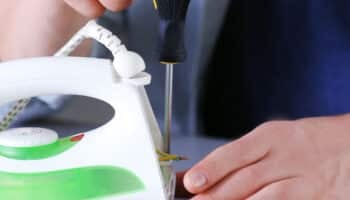You love your steamer and look forward to using it to save time and get the job done without a lot of fuss. However, the steamer recently started tripping your circuit breaker during use, and you’ve no idea why.
Sounds familiar? Don’t worry.
There are many common reasons why your steamer keeps tripping your breaker, sometimes even some uncommon ones. Luckily, you’ve come to the right place for answers. Below, you’ll find a list of useful information about the problem so that you can quickly get things back to normal.
Ready? Let’s go!
Is Your Steamer Shorting the Circuit?
Steamers, like any other appliance, can trip your circuit breakers, blow a fuse, or repeatedly short the circuit every time you use them.
Several reasons may cause tripping or shorting the circuit. The steps you take to stop the situation often depend on the cause, potential risks, and safety issues. Let’s look at the most common causes of a steamer shorting the circuit.
Tripped Circuit Breaker
Isolating your steamer as the culprit when your circuit breakers are tripping can be tricky, but there are some obvious signs. First, the tripped breakers only happen when you plug in your steamer or turn the steamer to the “on” position. Second, power goes out in some parts of your house, or the lights flicker when you turn the steamer on.
In my experience, resetting a tripped circuit breaker is an easy process, even for someone who has never opened the door to their electrical panel box.
- Unplug the steamer.
- Open the electrical panel or circuit breaker box.
- Look for the switch labeled for the room or area where the power went out when you used your steamer.
- Turn the breaker or handle completely to the “off” position.
- Wait a couple of minutes.
- Turn the breaker back to the “on” position.
Circuit Overload
A circuit overload generally occurs when too many appliances or devices are plugged into it. Circuit overload can also happen when you plug 2 high-power appliances into the same wall outlet.
Do not plug your steamer into the same outlet as your refrigerator, microwave, or other major appliance, and do your best to avoid using extension cords.
Corroded connections can also be to blame when your steamer keeps tripping your breakers and overloading the circuit. Check your steamer’s cord and the surrounding of the wall outlet.
Sometimes rats, moisture, and other factors can corrode your home’s wiring and cause issues.
Please avoid using a wall outlet with burn marks, and never use a steamer that produces sparks when you plug it into an outlet. If you suspect something’s wrong with your home’s electrical layout, contact a professional as soon as possible to address the situation.
Different Types of Steamers
Now that you know what might be causing the issue, it’s important to touch on the different types of steamers available to identify yours.
Various steamers, including garment steamers, steamer mops, carpet steamers, and small cooking steamers, may contribute to shorting the circuit in your home. Each steamer may seem very different, but in my opinion, when it comes to how they’re used, they do have some similarities.
You plug the steamer into an outlet and turn it on to get it to work. You use water to create the steam that is required for your steamer to function, as indicated in the description of the features or the product’s instructions.
The steamer potentially performs a function or solves an issue in less time than a traditional appliance.
Although these steamers collectively have similar features and functions, they also serve completely different purposes. Specific features and functions may also contribute to electrical issues that can lead to shorting the circuit.
Garment Steamer
Garment steamers typically come in two styles. One garment steamer consists of a small, handheld unit that you move across your clothes to steam out the wrinkles. Several people own handheld steamers, as they’re great for traveling since they can fit easily into a suitcase.
The second type of garment steamer consists of a unit with hoses or extensions. Extensions allow you to reach higher places and can also help keep you away from the high steam temperatures.
Such steamers are popular in the fashion industry and large dry cleaning businesses. From what I’ve seen over the years, garment steamers can cause short-circuiting and trip your breakers as easily as any other small appliance.
Steamer Mops
Unlike traditional mops, steamer mops are much more efficient at deeply cleaning and sanitizing floors. Steamer mops come in various sizes and styles and generate different amounts of steam or power.
A powerful jet of steam goes into the mop pad on the steamer mop.
The steamer mop is for maintenance cleaning of sealed floors. Following instructions for use and safety procedures can potentially help maintain your steamer mop’s life and may also help lessen the risk of the steamer tripping your circuit breaker.
Carpet Steamers
Carpet steamers give homeowners and renters the chance to thoroughly clean their carpets without worrying about the cost of hiring professional carpet cleaning services. Carpet steamers come in various brands and sizes and have multiple features across different models.
I find that when you use the carpet steamer, steam penetrates deep into the carpet, loosening dirt and stains on it. Vacuuming after the carpet dries helps provide a brand-new carpet’s look, feel, and smell.
That said, overworking your carpet steamer up to the point of overheating could explain why your steamer keeps tripping your circuit breaker. Some steamer models will beep to indicate many issues, so be sure to listen for any sounds.
Small Cooking Steamers
Using a small steamer pot probably seems like it would be simple, with very little need for special instructions. Yet, you’d be surprised by how many people don’t know how to use a food steamer properly.
Although some people opt for a steamer basket, others choose the electric food steamer. You get to choose from various settings, which gives you more control over steaming your food.
Fixing a Steamer That Keeps Tripping Your Circuit Breaker
When your steamer keeps tripping your circuit breaker, it’s understandable that you feel worried about the cost of repairs and a fire hazard.
Luckily, as I hope this piece has helped you better understand, addressing the most common causes behind a steamer that keeps tripping your breakers is easy and quick. More often than not, something as simple as taking breaks during long steaming periods will do the trick.
Thanks for reading. If this article was useful and answered your questions, please check out our other resources and free guides below and consider subscribing to our newsletter.
Happy steaming!
-Craig.







